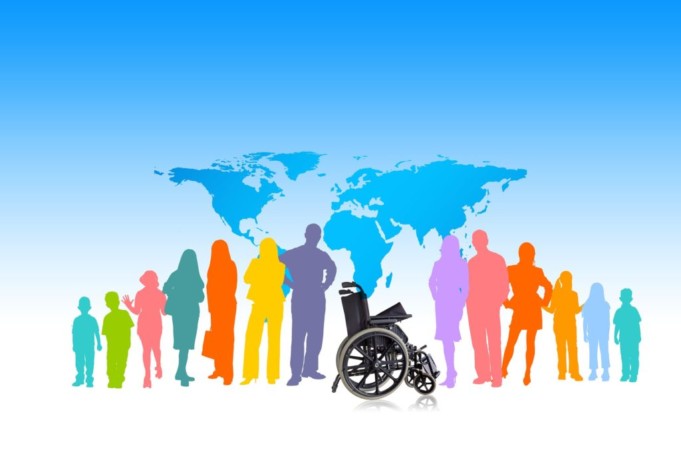For disabled people life is a lot different than the rest of us. They don’t lead normal lives like we do and need assistance for many of the things they need – which might seem normal to us.
That is a reason that society needs to evolve to understand their needs to help them lead a better life.
Understanding Disability
A disability is any conditions of the body or mind, which makes it difficult for the person to carry out his daily activities and live a full normal life.
It also can cause a person hindrance in interacting with the world around him. It may be present from birth or acquired during the lifetime of a person.
The Different Types of Disability
There are many types of disabilities but they are generally divided into the following categories:
1) Physical Impairment
A physical disability is the kind which affects the person’s mobility and dexterity. A person with this disability may need to use equipment to move around and carry on their daily activities.
Some physical impairment are temporary while some are permanent, some are from birth while some acquired later in life. The different types of disabilities include:
- Upper limb disability
- Lower limb disability
- Manual dexterity
- Disability in coordination with different organs.
Physical disability can be acquired or be present from birth or happen as a result from taking a particular medicine. For instance, people who have broken a bone, may not be always able to recover the way one would expect them to.
2) A Spinal cord Disability
This disability does often mean lifelong disabilities and is the result from the damages to the vertebrae, or sometimes, damages to the spinal cord itself.
You have two categories here, depending on the extent of the damage – complete or incomplete.
In the latter one, you do not lose the spinal cord’s ability completely In the case of a complete injury, the entire sensory organ does not function at all. The causes of this disability are:
- Motor vehicle accidents
- Falls
- Acts of violence
- Diseases
- Alcohol
- Sports and recreational activities
The two things people identify with disability are Paraplegia and Quadriplegia. The first results from spinal cord injury to the spinal cord, while the latter happens because of the damage to the spinal cord in the neck.
3) Brain Disability
A brain disability occurs due to brain injury and it can range from mild to severe, and most of the times, it is difficult to know the extent of the damage in the beginning. Acquired brain injury occurs after birth and is a result of disease, trauma, infection or lack of oxygen.
It is common for people with acquired brain injury to experience the following things:
- Increased fatigue
- Difficulties in learning and communicating
- Changes in behaviour and personality
- Slowing down when processing information or solving problems
- Troubles in concentration and memory
4) Intellectual Disability
People with intellectual, learning or cognitive disability have a difficulty in learning tasks and processing information i.e. it becomes difficult to take in information and communicate what they know.
They suffer from dyslexia, speech disorders and can also have problems with self-care, direction or safety.
The causes of intellectual disability can be;
- Genetic conditions
- Consumption of alcohol by mothers during pregnancy
- Childhood Diseases
- Poverty as the person does not receive enough nutrients
- Any illness that a mother gets during pregnancy
5) Psychiatric Disability
Also called mental health impairment, psychiatric disability affects the mind or brain. This disability can develop at any age and is, sometimes, not apparent to other people.
They are classified as;
- Bipolar disorder- This is a mental condition where there are alternating periods of elation and depression and causes changes in sleep, energy, thinking and behaviour.
- Anxiety- This includes phobia, panic disorders and also obsessive compulsive disorder.
- Depression- It is the most mental illness.
- Stress-related conditions
- Eating disorders- It’s common among people under the age of 30.
- Sleep disorders
- Schizophrenia- This is the most serious mental illness in which the person has disturbances in thinking, mood and behaviour.
6) Vision Disability
This disability refers to people who have partial or no vision at all. Only 10% of the people are totally blind and the rest 90% have a visual impairment.
This is caused by various reasons like accidents, diseases and congenital illness to name a few, and can lead to problems like blindness and ocular trauma or other problems.
Some of the common vision impairment includes;
- Scratched cornea
- Dry eyes
- Diabetes related eye conditions
- Scratches on the sclera
- Corneal graft
7) Hearing Disability
This includes people who are completely or partially deaf as well as people who are partially deaf and use a hearing aid to assist them. Many of them use a sign language to communicate – sign language is very common in the world, and it is not a restricted form of communication at all.
Deafness and hearing loss can be caused by a range of factors like physical damage, exposure to loud noise or disease during pregnancy. There are three types of hearing loss. They include:
- Conductive hearing loss- It occurs when the problem lies in the ear drum, ear canal or the middle ear and its bones.
- Sensorineural hearing loss- It is caused when the problem is in the inner ear also called as nerve-related hearing loss.
- Mixed hearing loss- This refers to combination of conductive and sensorineural hearing loss.
People’s attitudes are based on myth and prejudice, towards people with disabilities. They tend to discriminate or stay away from them. But these people are just like everyone else. Therefore, go show these people some love and make them happy.













